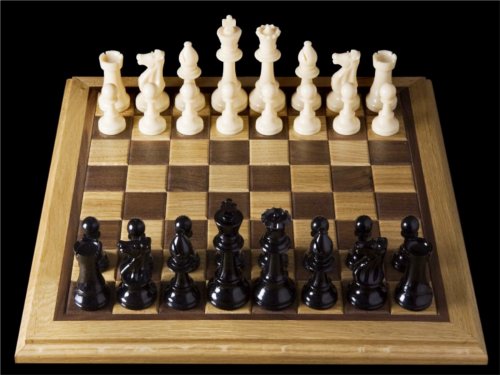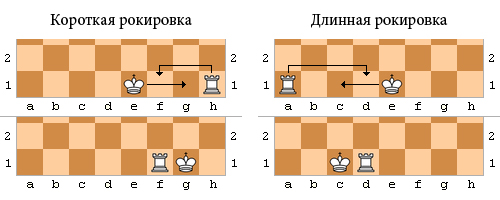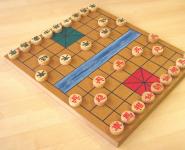Chess rules for beginners - chess placement, chess castling
To an ignorant person chess rules may seem simple enough, but in practice the situation is different.
To begin with, it is worth saying that chess is a game involving two people. The pieces they move with are located on different sides of the board, which contains 64 black and white fields.
Different figures alternately move along 64 squares of the board. The game begins with the correct installation of the board. It is necessary that each of the players have a white square in the lower right corner, respectively, black on the left.
The chessboard is marked horizontally with letters from a to h, in the vertical direction - with numbers from 1 to 8. It is with their help that the current game is recorded.
Because the article is quite large - we made it easy to navigate.
Article navigation:
The meaning of the game of chess
When the beginning of the game takes place, there are 16 pieces on both sides. The main goal of the game is to checkmate the opponent's king. Checkmate in this case is a situation in which the opponent's king cannot get away from the check. This situation takes place only when all the cells around are occupied by their pieces, or they are located under the attack of the opponent. Checkmate is also possible if it is impossible to close the check with another piece, or you yourself cannot take the piece that declared the check.
Arrangement of pieces in chess
If you do not know how to arrange chess on the board, then read this paragraph. Opponents play on opposite sides of the board, one of them moves with white pieces, the second with black pieces. The pieces in each game are placed in the same way as follows:
- Lines number 2 and 7 are pawns;
- The corners of the board are rooks;
- Next to the rooks are horses;
- Next to the horses are elephants;
- In the middle - a queen (should stand on a cell of the same color as it: white - on white, black - on black);
- Next to the queen is the king.
The first move in the game goes to the player with white pieces (the decision on who plays which pieces is made by lot). So, first the white pieces move, then the black ones, then again the white ones, then the black ones, and so on.
In the image below you can see how to correctly arrange the chess pieces.

How chess pieces move
The most significant and significant chess piece is the king. Possible moves of the piece: diagonally, horizontally, vertically to the adjacent field. The king does not have the right to make moves to an adjacent field if it is attacked by one of the opponent's pieces, or if another piece of the same color as the king is on this field.
The queen is the most powerful piece in chess. Its conditional value is 8 pawns. It combines the strength of both the rook and the bishop, as it can move vertically, diagonally and vertically (if there are no other pieces on the way).
The rook has the right to make moves in the vertical and horizontal direction, if there are no other pieces on its way. The conditional value of a rook is 5 pawns.
The bishop can move diagonally to any square, as long as there are no other pieces there. There are black-sexed and white-skinned elephants (the first ones walk through the black fields, the second - white ones).
Knight - conditional value - 3 pawns. Possible year - in the form of the letter "G". This means that at the beginning of the turn, it can move two spaces in the vertical direction, after which it can move one space in the horizontal direction. It is also possible for the knight to move - one square in the vertical direction and two - in the lateral horizontal direction. The knight piece has the right to "jump" over other pieces.
Pawns have the right to move in the vertical direction, but they can also attack diagonally and take the place of the piece that was beaten. In a situation where the pawn is in its original position, it can move through one square or move only to the next square forward. In the case when she is already in the game (that is, she made moves), then she can only move one square forward.
Turning and taking on the pass
A distinctive feature of pawns is that they have the right to become other pieces (except the king). To do this, the pawn must reach the last line of the board (the first one for black and the eighth one for white). The choice of a piece is carried out by the player who makes the move. As a rule, a pawn is promoted to a queen.
Also, a pawn can capture on the aisle, that is, capture another player's pawn piece, which was moved simultaneously to two cells of the board.
Castling in chess
Castling occupies a special place among all the rules of the game of chess. How to castling in chess is described below. This move makes it possible to simultaneously move the rook out of the corner of the chessboard so that it takes a more advantageous position, as well as to secure the king. The essence of castling is that the king piece changes position towards its rook by two squares, after which the rook moves to the adjacent square on the other side of the king piece. However, long castling in chess cannot be done just like that, for this a number of important conditions must be met:
- The king moves for the first time in the current game;
- The moved rook moves for the first time in this game;
- There are no other pieces on the squares between the pieces of the king and the rook, they are free;
- The king is not in a check situation, and the squares he is about to occupy or cross must not be occupied and attacked by enemy pieces.
Below is a picture that will show you how to castling correctly. The picture shows short and long castling.

Chess: rules of the game. Checkmate
At the beginning of the article, it was said that the main goal of a chess game is to checkmate the opponent's king. To do this, the king must get into check, but he can get out of it using one of three ways:
- Ensure safety by moving to another square of the board (castling is not allowed in this case);
- To take a piece himself, with the help of which the opponent is going to check (if possible);
- Defend against an attacking piece with another, with your own piece.
If it is impossible to avoid checkmate, the game comes to an end. In this case, the king remains on the board, but the game is considered over.
Also, if you want to learn how to play chess, learn the basic rules, you need to know when a draw is declared. There are 5 rules:
- If a player should move next, but cannot do so due to the position of the pieces;
- Consent from both players;
- The lack of a sufficient number of pieces on the board, allowing you to checkmate the opponent;
- 50 consecutive moves were made, however, none of the opponents made moves with pawns, as well as capturing a pawn or piece of the opponent;
- The player can declare a draw in the event that there was a three-time repetition of identical positions.
Blitz chess rules
Blitz chess is a chess game in which both players are given 5 minutes for each move. The rules for blitz chess are the same as for regular chess, the only difference is that all moves must be made very quickly.



